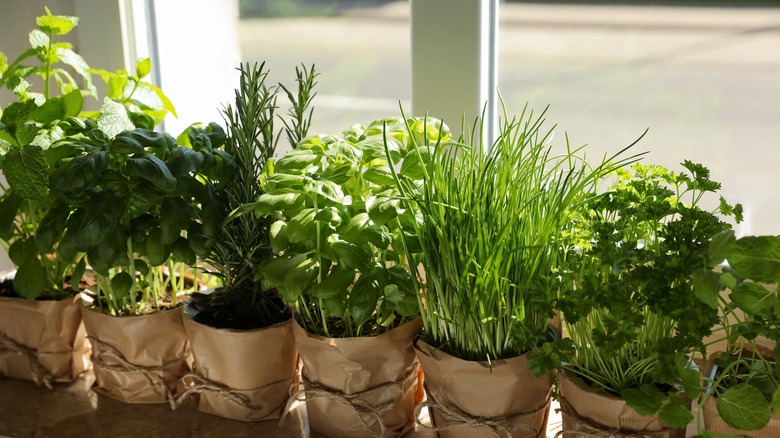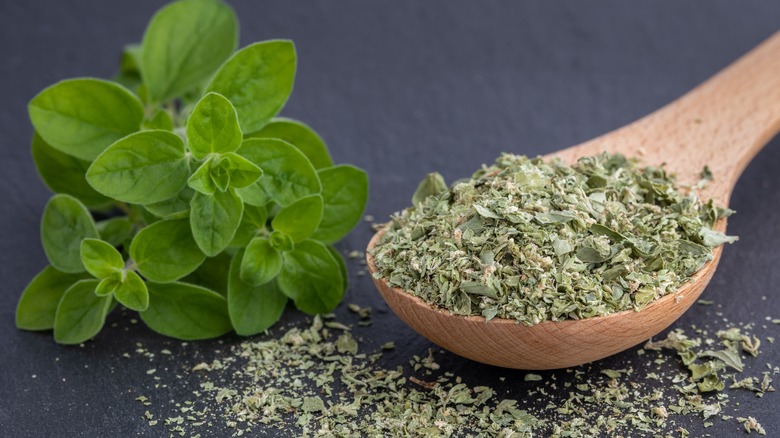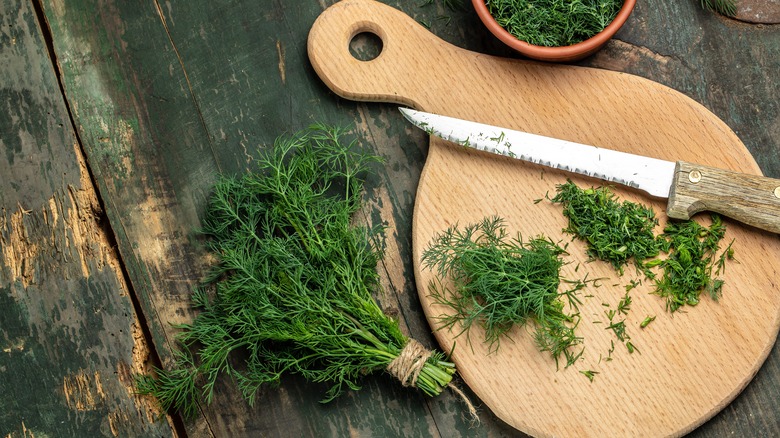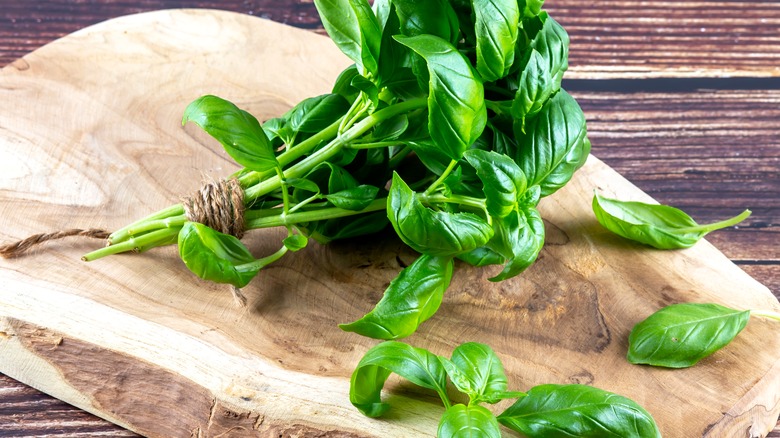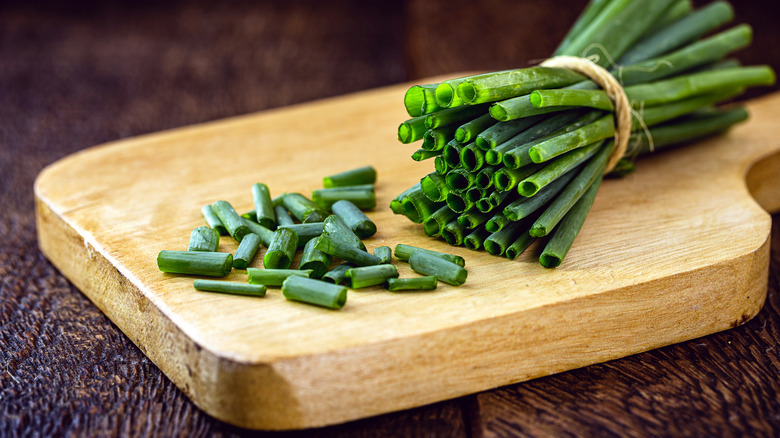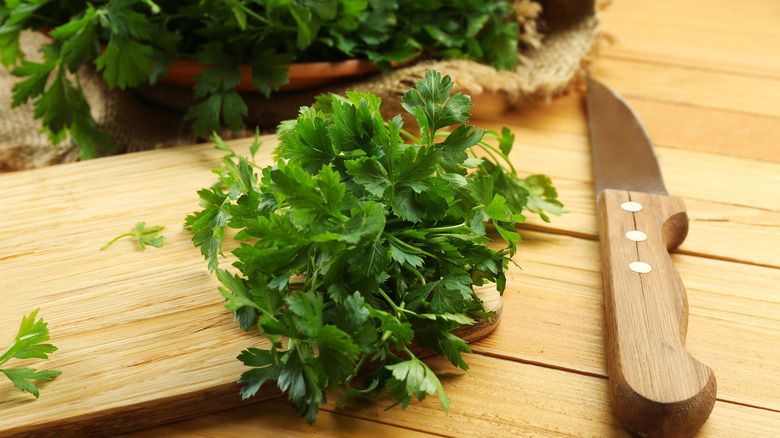5 Fast-Growing Herbs To Grow In Your Garden This Year
Every year, we rack our brains for what we should plant in our gardens during the sowing season. Herbs are some of the most accessible and beneficial plants we can grow. Not only can they be used in an endless array of recipes, but they can be utilized for medicinal benefits, home cleaners, and pest deterrents. Some herbs, like rosemary and bay laurel, can take quite a while to grow, so if you are an eager and impatient gardener, you'll be happy to know there are plenty of herbs ready to harvest within just a couple of months.
While you can encourage rapid growth for any herb through proper environments, pruning, and fertilization, some plants, such as oregano, dill, basil, chives, and chervil, are among naturally fast growers both inside and outside. Before you know it, you can sprinkle tasty herbs into your entrees and provide home remedies for all your problems.
Oregano
Oregano is native to the Mediterranean and West Asia, part of the mint (Lamiaceae) family. Oregano is applied in a variety of dishes across numerous cultures and is used so universally that it has been naturalized in countries such as Mexico and the United States. You can expect this herb to be ready for harvest within six to eight weeks, thriving in aerated soils with a pH level of approximately seven. It prefers full sunshine and should be allowed to dry between waterings as this plant isn't fond of consistently moist environments. It's noted that the best time to harvest oregano is in the morning when it's most potent.
The health benefits you can expect to gain from adding this herb to your savory dishes include reduced cholesterol, inflammation, and bacteria. It is an excellent herb for common colds, asthma, and diabetes and promotes heart health. Oregano is also frequently used in oils, which can then treat muscle pain and sore throat and be applied to cuts to fend off infection.
Dill
Dill derives from the celery family, Apiaceae, and is also known as Anethum graveolens. Dill is native to the Mediterranean and Southern Russia, producing several different varieties, with bouquet, compatto, and delikat among the most common. It grows extremely fast, ready to be collected in just 40 days after it first sprouts. Growing 8 to 30 inches tall, dill is best started indoors at the start of spring or planted outside when the warmth of summer has approached. This herb doesn't like to be transplanted, so wherever you sow, these seeds should be where they stay for the remainder of their lifecycle. Full sun, draining soil, and high organic matter help dill grow to the healthiest extent. Harvest regularly by cutting or pinching off four to five leaves at once, allowing it to continue producing all season long.
Dill doesn't just have to be used for pickles, being an excellent garnish for seafood and meats. It adds well to soups and salads and is often used to make pasta and dipping sauces. There are a plethora of nutrients that dill provides, such as iron, magnesium, zinc, and vitamins A, C, and D. It is known to increase the immune and reproductive systems, improve vision, and enhance bone health. Let's not forget that it can regulate diabetes and assist with sleep troubles.
Basil
This annual herb comes from the mint family, native to India. There are four common types of basil among the numerous varieties, including sweet basils, dwarf basils, purple-leaved, and scented basils. Ready within two months, it does best in soils kept moist by frequent waterings and won't need much fertilization, if any. It prefers to be set in a location with plenty of sun and can be started anytime in spring or summer. It's recommended that indoor basil receives a large receptacle to hold the amount of water it loves, and you'll want to harvest consistently to keep new growth coming in.
Used fresh and dried, basil is delicious in pizza and pasta dishes, sauces, salads, and dipping oils. It's often infused in teas, promoting acne and stomach ache relief. Also high in antioxidants, basil contains phenolics, which are attributed to cancer prevention, and is high in magnesium, advocating for heart health.
Chives
Chives belong to the allium vegetable family, also home to leeks, scallions, shallots, onions, and garlic. They are ready to harvest within two to three months, requiring full sun, rich fertilization, and a well-draining soil mix. Two common types of chives are typically grown — onion chives that feature hollow leaves and garlic or Chinese chives with flat leaves. Chives do well indoors and outdoors, but for outdoor sowing, keep in mind that they don't excel in summer's heat. Early spring or fall is best for outdoor planting. To harvest this herb, cut leaves at the base of the plant, completing this three to four times throughout the season.
Chives are used to garnish all sorts of dishes and are especially excellent in mashed potatoes, omelets, cheeses, and dips. The herb will produce edible flowers that boast a subtle onion taste and are used frequently in salads and seasonings and can even be eaten raw. Chives are found to positively affect gut and heart health, help with inflammation, and be high in vitamin K. It also has cancer-preventing agency and is known to enhance memory.
Chervil
Commonly known as French Parsley, chervil is a herb closely related to parsley but described as lighter in flavor with hints of anise. It doesn't frequent grocery stores or farmer's markets as much as cilantro or parsley, so this herb is especially convenient to grow at home. It can be ready within nine weeks, planted inside or out, and prefers to be kept shaded and out of extreme heat. Regular watering and fertilization will be beneficial in its growth. Spring and summer are the best planting seasons for chervil, and harvesting leaves can take place until its white flowers bloom, signaling the end of its lifecycle.
Chervil is used in dishes ranging from chicken and fish to stew, soups, and salads. It relieves burns and is a great vitamin C, carotene, iron, and magnesium source. It can also be added to tea, giving medical benefits such as relieving high blood pressure and treating conditions like eczema and kidney stones.
